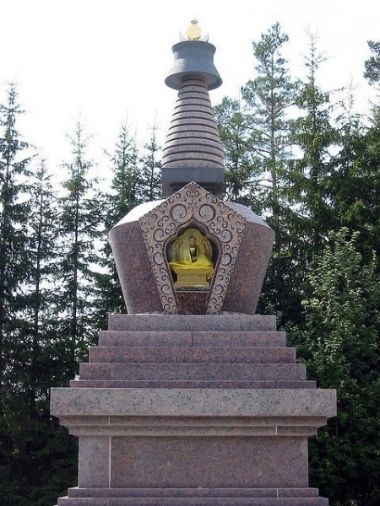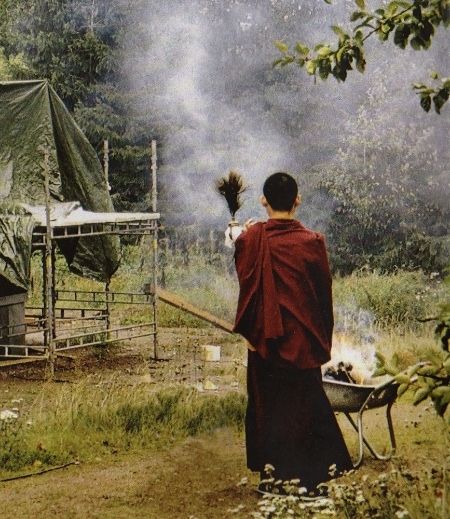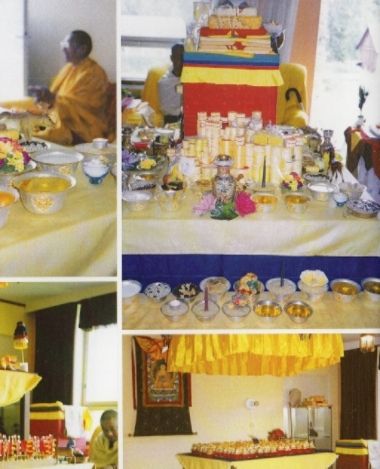FEATURES|VEHICLES|Vajrayana
The Siikainen Stupa: The Northernmost Stupa in the World
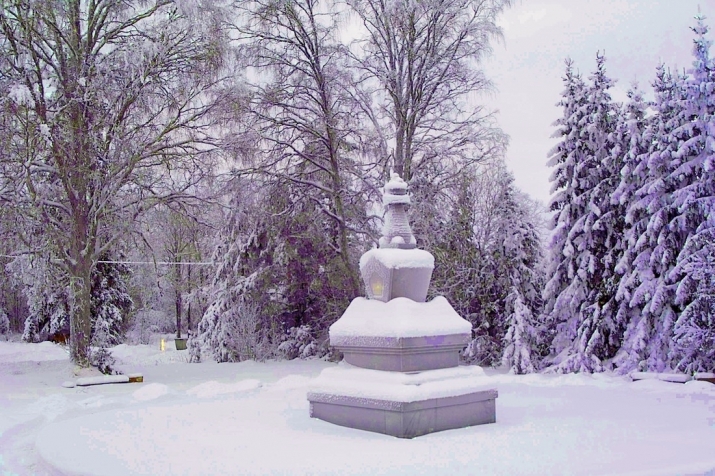 Image courtesy of the author
Image courtesy of the authorThe “Siikainen Stupa,” named after its location in the Siikainen Municipality, in the Satakunta region of western Finland, is the northernmost stupa in the world. This is the story of its construction.
The idea for the stupa traces back to the end of the 1970s, when our sangha was holding retreats in a detached house with some land around it just outside of Helsinki. I started doing some experiments with pyramids—we built some small ones on the land with wooden frames and open sides, based on the dimensions of the Kheops pyramid in Egypt, and practiced meditation under them. We were really amazed to discover that they seemed to create a certain atmosphere in the environment and to generate energy. This sparked an interest in different kinds of structure and suggested that different forms may have a particular effect, and as such, may influence a person’s state of mind in different ways.
My interest then shifted towards the form of the stupa, which is a structure not only with a variety of forms but also with symbolic meaning. At the time, there was a Japanese monk coming to Helsinki every summer in search of a site on which to build a stupa. However, he was unable to find a suitable place. Later, some other monks from the group he was affiliated with conducted a retreat in our house. Inspired by the Japanese monk, when we established a new retreat center in the Finnish countryside the following year, we also had the idea to build a stupa. We discussed it and built some small, experimental structures, but the project didn’t quite get off the ground.
Then, when Tulku Pema Wangyal came from Dordogne in France to visit our center in the early 1990s, I told him about our plans, and he was interested. A few years later, he wrote and told me that it would be good if we could start the stupa project and that we could avail ourselves of his expertise. I had originally met Tulku Pema Wangyal in Dordogne in 1990, in connection with the teachings of His Holiness Dilgo Khyentse Rinpoche. Tulku Pema told me that it was Dilgo Khyentse’s wish that 108 stupas be built all over the world, and he thought the stupa in Finland could be one.
There were already several stupas in Europe—in France, and also in Italy, about which we had some information and also some video material. In these countries, the stupas were built from limestone and sandstone, which are easy to work. However, these materials would have been too fragile to withstand the cold Finnish winters, and would have suffered damage through erosion. We therefore decided that granite would be an ideal material for a Finnish stupa, despite it being hard and difficult to work, and started to inquire where we could purchase some as well as how to work it.
At first we looked locally, but the price was well over our budget. Then we considered Estonia, which had just gained independence from the Soviet Union, but we felt that conditions there were still too unstable. Another possibility was Nepal, in which the so-called “black stone” was available, but the cost of transport would have been far too high. We knew that small stupas had been transported from Nepal to Germany, but we meant to have a bigger structure, over 16 feet tall. This represented quite a big challenge, even though on a global scale it is not so very large. Then, during a trip to Calcutta with a friend, we got to talking about the stupa, and he said he knew some Japanese who had had their stupas made in Odisha (Orissa), in eastern India, where granite is also available. Interestingly, it became clear that the Japanese in question were the very same monks who had visited Finland and done retreat in our center. However, the problem of transportation remained.
Things finally got under way when we found a workshop in the Finnish province of South Karelia that was able to cut stone with great precision. For instance, they had made granite balls around 5½ feet high that could pivot on just a small amount of water, for use in Disneyland. When we told them a stupa symbolizes the elements, harmony, and peace, they became enthusiastic about our plans, so we asked them to make the most challenging parts. Karelia is known for the good quality of its granite, and we purchased the other stone components from a place in North Karelia. By the end of the 1990s, we had managed to acquire all the stone elements and they had been transported to our Dharma center, where the foundation for the stupa had already been laid. However, a year later we purchased a new retreat center, located farther north in Siikainen on a larger property, which we felt might be a better place for the stupa, and the stones were transferred to the new location. We had the idea that it would be a Buddhist retreat center—perhaps a monastic type of place.
The construction of the stupa did not only consist of purchasing the stone elements—another important step was the preparation of the objects to be placed inside. For instance, one winter we made 3,000 small statues (Tib. tsatsa) out of clay. In addition, in the spirit of global harmony, we obtained different grains and water from around the world, as well as other substances traditionally placed inside a stupa. In 2001, Tulku Pema Wangyal together with his younger brother Jigme Khyentse Rinpoche, members of his center in Dordogne, and monks from both France and Nepal came to help us build the stupa—we wanted to employ traditional Tibetan methods to ensure it was as authentic as possible. The stupa also contains some especially rare and precious relics, including those of Buddha Shakyamuni, Yeshe Tsogyal, Milarepa, His Holiness Dilgo Khyentse Rinpoche, and His Holiness Dudjom Rinpoche. It was consecrated in September 2001.
The meaning of the stupa
The meaning of the stupa is manifold. It is not possible to know how exactly how it works, or will work, because the extent of its activity spans hundreds, if not thousands, of years. However, over time, the stupa will affect the environment in such a way that people’s skepticism and reservations will start to disappear and interest in the stupa will arise. While we can only guess at how it operates on the subconscious level, traditionally a stupa is thought to remind one of both the potential for and fruit of enlightenment, and as a monument in itself, it generates equanimity, peace, and harmony.
I personally experienced something of the meaning of a stupa when I visited Sri Lanka in 1984. The civil war had broken out, and it was difficult to travel to the north. Thus, I was in the south. When I meditated, however, I was surprised to experience visions of the dagobas in the north, which showed me that stupas and dagobas are more than just monuments. They truly have a significance and an effect on levels beyond our comprehension.
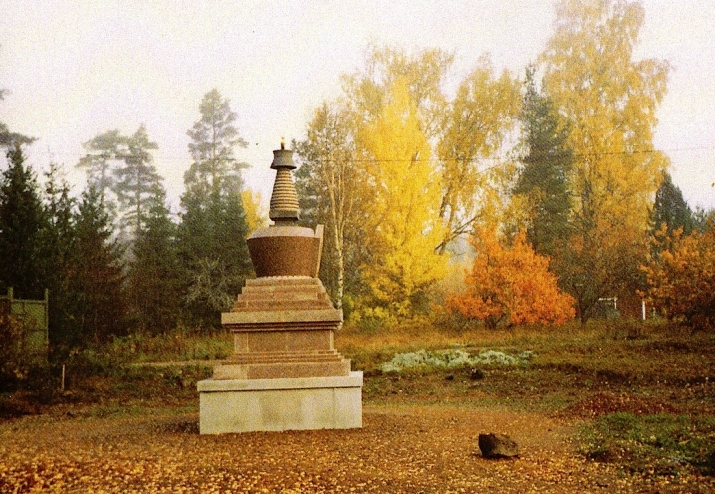 Image courtesy of the author
Image courtesy of the authorWhen someone sees the Siikainen stupa for the first time, they often ask what it represents. One can then explain the essential points of the Buddhist teachings and the higher aspirations and potential of, and possibilities for, humankind. The sight of a stupa will always turn one’s mind towards spiritual development and liberation. The Siikainen stupa has also shown its influence in that we have had some outstanding Tibetan lamas teaching in our Dharma center, and next summer we hope to receive HH Sakya Trizin.
The fact that a stupa was built in Finland means that Buddhism has definitively arrived in our country; moreover, the site of the stupa will always be a Buddhist retreat center and thus guarantees a place where Buddhism can be practiced in the Nordic countries. We can imagine that the stupa is a lighthouse—in Finland, in Europe, on Earth—guiding seekers to safety through the treacherous waters of samsara.
Ngakpa Maitreya (Pekka Airaksinen) is the founder of the Samje Centre, which was established in 1998. Now called the Buddhist Dharma Centre and located in Siikainen, around 185 miles from Helsinki, the center hosts visiting lamas and is primarily used for retreat. It is a registered Buddhist organization.

